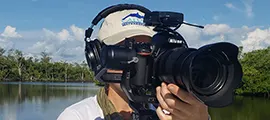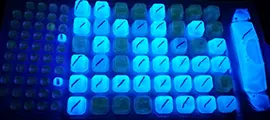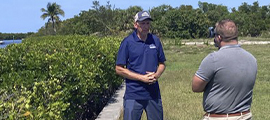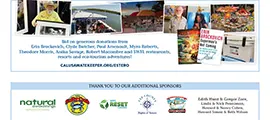Issue:
Stormwater Management

The effects of a rain event from the Caloosahatchee watershed, which often includes Lake Okeechobee discharges.
Stormwater & Nutrient Pollution
As the landscape is cleared for various uses, flood control measures typically create more water quality problems. Stormwater is engineered to run off into canals and waterways much quicker than in the natural systems which allowed for standing water and the filtering of pollutants by wetlands. Ditching, dredging and road building throughout Florida, has altered floways and accelerated runoff in many watersheds. This leads to downstream impacts to receiving waters from stormwater runoff, especially after large rain events.
Stormwater runoff is a dynamic vehicle that introduces many pollutants into our waters, including nitrogen, phosphorous, fecal bacteria, copper, mercury, plastics and more. Whether we’re talking about agricultural or residential uses, the development, fertilization, irrigation and flood control decisions we make on land have a lasting impact on water quality.
Stormwater management and oversight in Florida is a somewhat complex web of government and stakeholder involvement. Land owners, cities, counties and Community Development Districts (CDDs) are all responsible for compliance with the National Pollutant Discharge Elimination System (NPDES) which the state’s Florida Department of Environmental Protection (FDEP) is charged with overseeing. The state’s water management districts also play an important role in flood control projects and stormwater permitting on larger developments.
Many of our other priority issues are related to stormwater loading. For example, Lake Okeechobee discharges are driven by rainfall, carrying legacy nutrients and pollutants. Excess nutrient loading (pollution) of nitrogen and phosphorous are the primary fuel for harmful algal blooms.
When water on our landscape is not allowed time to percolate through the ground or a riparian buffer, it is often inadequately treated in stormwater treatment areas or drained directly into our waterways, taking contaminants with it.
Nutrients & Other Impairments
The Florida Department of Environmental Protection (FDEP) oversees the assessment and verification of impairments to Florida waters. There are a variety of parameters that cause impairments, with the most common being for nutrients (nitrogen or phosphorous), dissolved oxygen, fecal indicator bacteria, turbidity, copper and mercury.
The process of classifying, grouping and assessing our waterbodies is quite laborious and complex. In our view, both the Basin Management Action Plans (BMAP) and accompanying Total Maximum Daily Loads (TMDL) programs, created by the Florida legislature, are largely failing to protect and restore Florida’s impaired waters.
At Calusa Waterkeeper, we are doing our best to independently analyze the state’s stormwater rule-making process, vet local Municipal Separate Storm Sewer System (MS4) permits, identify possible NPDES stormwater violations and hold FDEP and polluters accountable to monitoring requirements and restoration plans.

By the Numbers
Water Quality Trends in SWFL
In 2021, Calusa Waterkeeper began a novel assessment of our local water quality trends using FDEP’s impairment data. This is a relatively comprehensive and unbiased way of determining local water quality trends.
This impairment assessment summary also represents a baseline that can be easily updated from annual FDEP comprehensive verified lists in association with evaluation criteria, such as population growth, that contribute to impairment as presented here. A relatively narrow initial period of record was chosen that would include the latest changes in assessment criteria for added inter-year comparability.
The summary may also provide a basis for evaluating restoration effectiveness by understanding net change in impairment through time.
Read More
Related News Stories
Stormwater
ACTION ALERT: Contact Our Governor to Veto These Bills
With the 2021 Legislative Session now closed, Calusa Waterkeeper is urging our supporters and followers to contact the Governor to veto the following bills that have a strong nexus to water, unabated development and the negative impacts that result.
Lake O Releases Being Sent to Caloosahatchee to Avoid Wet Season Problems
More water from Lake Okeechobee is scheduled to be sent to the Caloosahatchee River, as the U.S. Army Corps of Engineers plans to increase water releases now to potentially avoid the need for too many releases during the wet season. It’s a decision a water expert in Southwest Florida calls a gamble.
Florida Law does Little to Clean up Waterways
Florida’s waterways have been choked by blue-green algae and red tide for years, and are now on life support. However, the Clean Waterways Act signed into law this summer does very little to help Florida’s ailing waterways.
Aerial Images of SWFL Shores Shows Dark Water Discharge
A non-profit organization dedicated to protecting waterways in Lee County took pictures of shorelines to show the effect of recent water releases from Lake Okeechobee. Plus, researchers from SCCF detected a medium level of red tide in the waters around Sanibel.
Construction Site Runoff Causing Murky Water in Downtown Fort Myers
There is brown water working its way into the Caloosahatchee River. It’s happening next to two construction sites off West First Street in Downtown Fort Myers. Calusa Waterkeeper John Cassani said he has sent photos of the turbid runoff to the Florida Department of Environmental Protection.
Once Again, Dirty Water Flows into the Caloosahatchee from Downtown Fort Myers Construction after Eta’s Soaking
Once again, two construction sites have dumped polluted stormwater into the Caloosahatchee in downtown Fort Myers. Barriers around the work sites failed to contain the dirty runoff following Tropical Storm Eta’s multi-day soaking. State officials are investigating the City Walk and Silver Hills properties
Make a Donation
Get Notified
Priority Issues
Harmful Algal Blooms
Cyanobacteria & Red Tide
Cyanobacteria (blue-green algae) and Karenia brevis (red tide) have been making major impacts on Southwest Florida.
Lake Okeechobee Discharges
Revise System Operating Manual
The Caloosahatchee River often suffers from too much freshwater in the wet season, and not enough freshwater in the dry season.
Cape Coral Spreader Canals
Nutrient & Sediment Loading
The City of Cape Coral is working to remove large storm-water barriers to make recreational boating more convenient.
Bacteria Monitoring
Fecal Indicator Bacteria
Calusa Waterkeeper has been at the forefront of monitoring this Fort Myers tributary for fecal bacteria indicators.



































